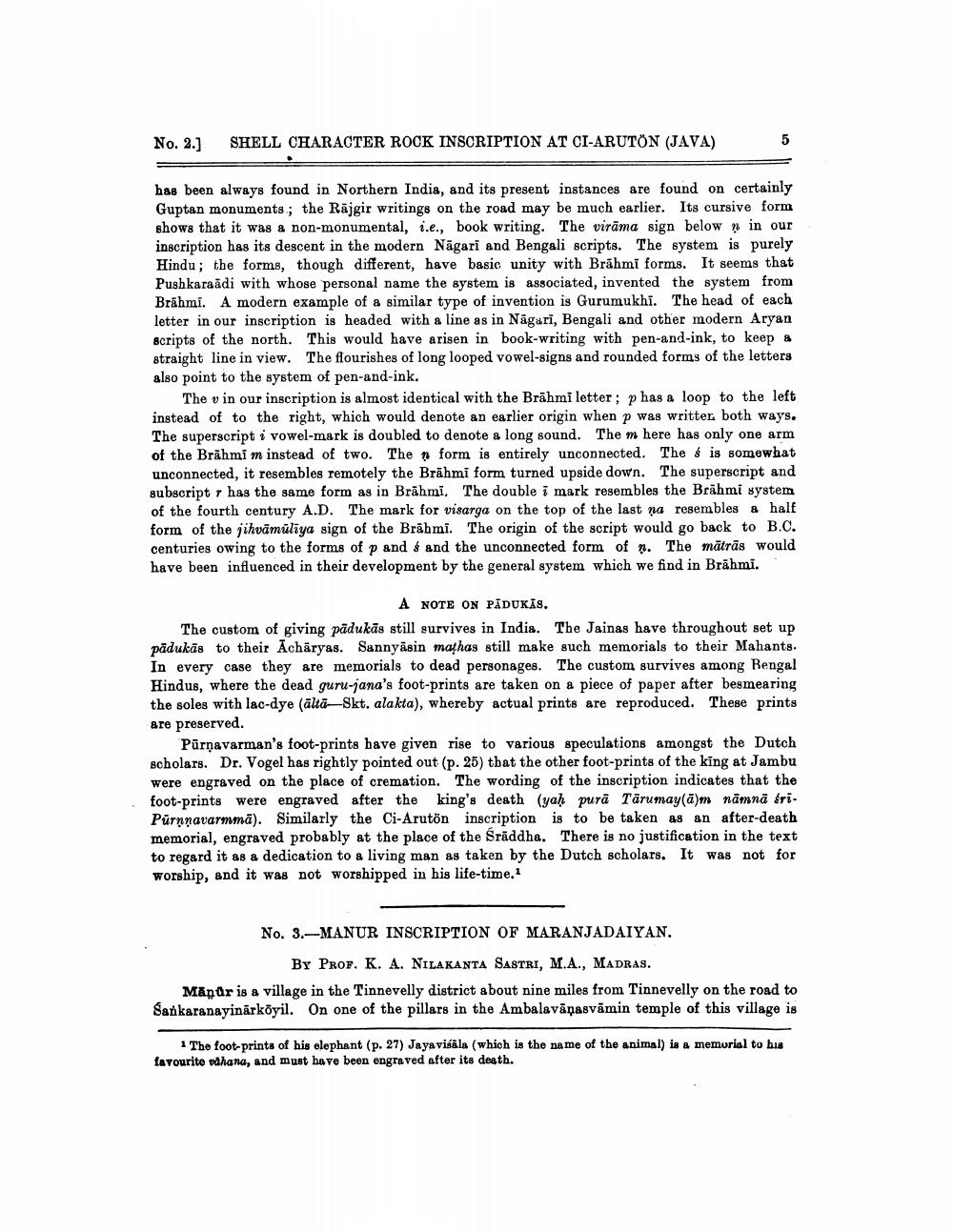________________
No. 2.)
SHELL CHARACTER ROCK INSCRIPTION AT CI-ARUTON (JAVA)
has been always found in Northern India, and its present instances are found on certainly Guptan monuments; the Rajgir writings on the road may be much earlier. Its cursive form shows that it was a non-monumental, i.e., book writing. The virāma sign below » in our inscription has its descent in the modern Nāgari and Bengali scripts. The system is purely Hindu; the forms, though different, have basic unity with Brāhmi forms. It seems that Pushkaraadi with whose personal name the system is associated, invented the system from Brāhmi. A modern example of a similar type of invention is Gurumukhi. The head of each letter in our inscription is headed with a line as in Nāgari, Bengali and other modern Aryan scripts of the north. This would have arisen in book-writing with pen-and-ink, to keep & straight line in view. The flourishes of long looped vowel-signs and rounded forms of the letters also point to the system of pen-and-ink.
The v in our inscription is almost identical with the Brāhmi letter; p has a loop to the left instead of to the right, which would denote an earlier origin when p was writter both ways. The superscript i vowel-mark is doubled to denote a long sound. The m here has only one arm of the Brāhmim instead of two. The form is entirely unconnected. The $ is somewhat unconnected, it resembles remotely the Brāhmi form turned upside down. The superscript and subscript has the same form as in Brāhmi. The double i mark resembles the Brāhmi system of the fourth century A.D. The mark for visarga on the top of the last na resembles & half form of the jihvāmūliya sign of the Brāhmi. The origin of the script would go back to B.C. centuries owing to the forms of p and $ and the unconnected form of . The mätrās would have been influenced in their development by the general system which we find in Brāhmi.
A NOTE ON PĀDUKĀS. The custom of giving padukās still survives in India. The Jainas have throughout set up pādukās to their Acharyas. Sannyasin mathas still make such memorials to their Mahants. In every case they are memorials to dead personages. The custom survives among Bengal Hindus, where the dead guru-jana's foot-prints are taken on a piece of paper after besmearing the soles with lac-dye (altā—Skt. alakta), whereby actual prints are reproduced. These prints are preserved.
Pūrņavarman's foot-prints have given rise to various speculations amongst the Dutch scholars. Dr. Vogel has rightly pointed out (p. 25) that the other foot-prints of the king at Jambu were engraved on the place of cremation. The wording of the inscription indicates that the foot-prints were engraved after the king's death (yah purā Tārumay(ā)m nämnā triPurnnavarmmā). Similarly the Ci-Arutön inscription is to be taken as an after-death memorial, engraved probably at the place of the Srāddha. There is no justification in the text to regard it as a dedication to a living man as taken by the Dutch scholars. It was not for worship, and it was not worshipped in his life-time.
No. 3.-MANUR INSCRIPTION OF MARANJADAIYAN.
BY PROF. K. A. NILAKANTA SASTRI, M.A., MADRAS. Mänar is a village in the Tinnevelly district about nine miles from Tinnevelly on the road to Sankaranayinärköyil. On one of the pillars in the Ambalavānasvāmin temple of this village is
1 The foot-prints of his elephant (p. 27) Jayavisāla (which is the name of the animal) is a memorial to bus favourito odhana, and must have been engraved after its death.




